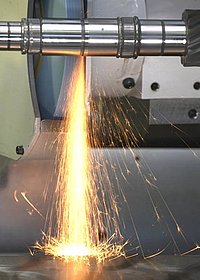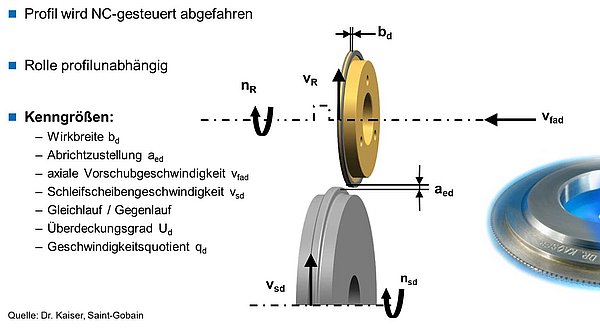Interferences on the cooling lubricant supply during grinding - Part I
The objective of a cooling lubricant supply that meets the requirements is a thermally damage-free machining of components to achieve the highest form and dimensional tolerances in the shortest machining time. The grinding process involves various disturbance variables that can negatively affect a cooling lubricant supply that meets the requirements. These will be listed and briefly explained in this magazine article by Team grindaix. You can find a comprehensive technical explanation of all influencing variables and their disturbance character on our YouTube channel in the topic "Avoiding grinding burn" and on our Innovation Days.
Basically, we distinguish between the possible disturbance variables between influences from the areas:
a) Process control of the grinding process
b) Process control of the dressing process
c) Materials technology
d) Cooling lubricant (oil, emulsion, aqueous solution)
e) Cooling lubricant system
f) Cooling lubricant nozzle
g) The air cushion rotating with the grinding wheel
In this Part I, points a) to d) are dealt with. Click here to go to Part II.
a) Process control of the grinding process
In the grinding process, the infeed or, better, the related metal removal rate Q'w can be improperly selected so that the chip thicknesses (lengths) of the grinding chips become so large that they clog the pore spaces of the grinding wheel bond near the surface. This means that the accessible pore spaces are virtually smeared with soft component material (hot chips).
The result is that these pore spaces are no longer available for the transport of cooling lubricant into the machining zone. This means that theoretically no cooling lubricant reaches the actual chip formation process, and the cooling and lubricating effect of the cooling lubricant is lost. The component is thermally overheated.
A second effect of such grinding tool bond additions is the increasing friction between the grinding tool (bond) and the component during the grinding process. Here, too, thermal influences occur which can negatively affect the edge zone properties of the component to be ground.

Figure 2: Grinding process
b) Process management of the dressing process
If the grinding tool is dressed improperly (too fine) with reference to the selected grinding process setting (Q'w), there will be too much friction between the grinding wheel and the component. On the one hand, we need a sufficiently rough grinding tool to be able to realize high metal removal rates. On the other hand, the grinding wheel should not be dressed too roughly so that the required surface quality can be achieved. Therefore, a compromise must be sought between a grinding tool that is as easy to cut as possible and a sufficiently fine component surface that can still be achieved. The choice of dressing parameters has a decisive influence on the surface topography of a grinding wheel.


Figure 3: Dressing process Figure 4: Dressing
The terms commonly used here, such as the dressing coverage Ud, the dressing speed quotient qd, the effective width of the dressing tool bd, the dressing infeed aed and also the feed rate in the dressing process are decisive influencing variables on the subsequent thermal edge zone damage of the component surface. No matter how professionally designed the cooling lubricant supply system is, it will be virtually ineffective if the pore spaces in the grinding tool cannot be used to transport the cooling lubricant as required. The grinding tool is the cooling lubricant carrier. If the pore spaces, as a result of an incorrectly designed dressing process, are too small in relation to the chip sizes produced in the grinding process, clogging effects will occur in the grinding tool surface, as already described. The result is grinding burn.
c) Materials engineering
The material to be machined cannot usually be varied and is a customer requirement. But if you understand which material components are present, you can derive specific information for a grinding burn potential.
A basic distinction is made between hardened material and unhardened material. The term hardening refers to a heat treatment of the component material to be machined. As a result, the component is given specific boundary zone properties that make it robust against mechanical but also chemical stresses and suitable for subsequent precision machining during its subsequent use (intended application). Soft microstructural constituents of the materials to be machined lead to clogging of the pore spaces of the grinding tool during the grinding process. These are then no longer available for the necessary cooling lubricant transport into the grinding zone. Hard microstructural constituents are desirable because they cause short chips and thus reduce the tendency to clogging.
Which microstructural constituents have which clogging influence in which form is discussed in detail in the technical seminar Avoiding Grinding Burns, not only for steels, but also for high-temperature materials such as titanium and nickel-based alloys, but also for high-hardness materials such as ceramics, hard metals and high-speed steels as well as tool steels.
d) Cooling lubricant
The type and composition of a cooling lubricant exert an equally decisive influence on thermal damage-free grinding. Emulsions are usually mixtures of mineral oil (approx. 4-9%) and water (91-96%). Although they have a very good cooling effect due to their relatively high water content, they also tend to foam. A highly foaming emulsion causes the water content of the cooling lubricant fed into the process via the free pore spaces of a grinding wheel to drop sharply. This reduces the cooling capacity, which in turn can lead to thermal damage to the component. The heat only has the choice of either remaining in the grinding tool, being absorbed into the cooling lubricant or migrating into the component.

Figure 5: Heat flow
The latter effect is not desired. The grinding wheels are usually ceramic, or resin bonded. These materials are less likely to dissipate heat. Therefore, the aim must be to dissipate the heat generated in the grinding process via the cooling lubricant. The low biological resistance of an emulsion can lead to the formation of fungi, which can cause deposits in cooling lubricant pipes and cooling lubricant nozzles. In extreme cases, this can lead to clogging of the nozzles and lines. For this reason, cooling lubricant nozzles that are operated with emulsion must be cleaned automatically at discrete time intervals as required. Furthermore, it is difficult to accelerate a foaming emulsion through pressurized cooling lubricant nozzles in such a way that it has sufficient kinetic energy to penetrate the air cushion rotating with the grinding wheel. In most cases, foaming emulsions only reach the vicinity of the machining zone improperly at best and therefore do not contribute to the cooling of the grinding process as required. Oils, on the other hand, have a lower heat absorption capacity than water, but lubricate the chip formation process in such a way that less frictional heat is generated.
These two contrary effects (emulsion cools better lubricates poorly / oil lubricates very well but cools poorly) usually cancel each other out and the preferred choice of one or the other type of coolant cannot be evaluated across the board without considering the other aspects (economy, environmental requirements, human compatibility). Oils exhibit a viscosity-temperature behavior. This must be taken into account when talking about precise cooling lubricant feed rates in grinding processes. Oils can also exhibit foaming behavior. This is referred to as the air content of the oil (in %). Here, too, undesirable effects occur with regard to the reducing lubricating effect of an oil with a high air content. We will deal more specifically with aqueous solutions in the technical seminar. It should be mentioned here that aqueous solutions basically behave very similarly to emulsions in terms of heat absorption capacity.
Do you have any further questions?
We are always available to answer your questions about our products and services. You can reach us by e-mail at info@grindaix.de or by phone at 02273 95373 0 (weekdays from 8 am - 5 pm).
Relevant products in this article:
These articles from our magazine might also interest you:
Electromagnetic flow measurement
In electromagnetic flow measurement (EMF), an electrical voltage is generated by the interaction between the flow velocity of a liquid and a magnetic field. This principle is based on Faraday's law of induction.
Lubricoolant protective filtration
The use of cooling lubricants always requires the operation of a filtration system that meets the requirements, because the influence of the purity of the cooling lubricant is considerable. We have therefore compiled a list of what is important in cooling lubricant filtration.




